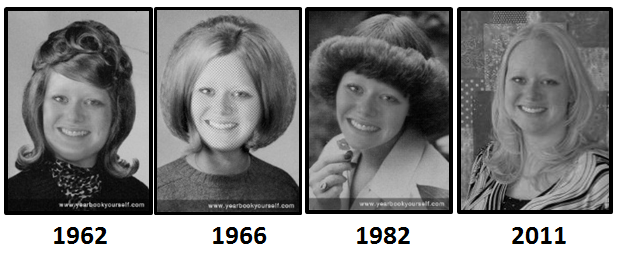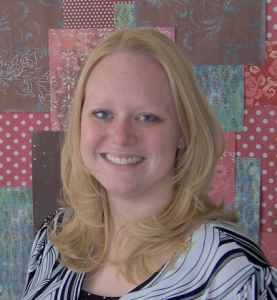To help students understand my approach to education, I tell them about the website www.yearbookyourself.com. On this site one can upload his/her own photo and merge it with a large set of stock “yearbook” photos, images that represent the hairstyles and clothing of different decades over the past half century. The new visions of one’s self are often humorous, but I also point out to students that not all images are a perfect fit. I show them possibilities where the photo’s face shape doesn’t mesh with my own or where the new image is downright unflattering. On the other hand, some of the new pictures are a perfect fit; I look quite fetching with a 1966 bouffant hair-do, for example. The point, I explain to students, is that while none of those images are me as I am today, each offers a new way of seeing myself and a new vision of how I might fit into the world. Into each image is coded a different time period with its differing beliefs, values, and understanding of the world, and considering who I am in relation to those beliefs, values, and views of the world allows me to better develop and understand my own worldview. The same is true of the various narratives, theories, and philosophies we explore as part of a liberal arts education—some will fit perfectly and others will be completely unsuitable. However, we won’t know which is which until we try them on and look at the world from new perspectives.
 My approach to teaching is a student-centered one categorized by three major principles. First, I believe authentic learning includes risks: trying on new ideas that may or may not fit, seeing from another’s perspective—even, and especially, when it makes us uncomfortable—and being open to the possibility that we do not know as much as we might think we do. Second, I believe that the most effective and best learning is that which comes from inquiry: asking questions, engaging in dialogue, and seeking out new understandings of the communities and world we inhabit. Third, I believe in encouraging comprehensive intellectual curiosity, even if that curiosity is not directly connected to my intended course materials. After all, the greatest discoveries often arise from completely different paths of inquiry.
My approach to teaching is a student-centered one categorized by three major principles. First, I believe authentic learning includes risks: trying on new ideas that may or may not fit, seeing from another’s perspective—even, and especially, when it makes us uncomfortable—and being open to the possibility that we do not know as much as we might think we do. Second, I believe that the most effective and best learning is that which comes from inquiry: asking questions, engaging in dialogue, and seeking out new understandings of the communities and world we inhabit. Third, I believe in encouraging comprehensive intellectual curiosity, even if that curiosity is not directly connected to my intended course materials. After all, the greatest discoveries often arise from completely different paths of inquiry.
To facilitate learning with these principles in mind, I work hard to ensure that my classroom offers safe space for engaging with challenging and difficult ideas. In practical terms, my pedagogy means that I emphasize student-centered and guided learning in class, although I do offer mini-lectures when appropriate. I primarily assess students through projects (usually written) that illustrate the process and goal of engaging with theories, texts, artifacts, and ideas from the course rather than requiring the recitation of specific information. I also routinely offer the opportunity for students to engage in interdisciplinary projects of their own design, whether academically traditional or creative, that allow students to work with my course materials in ways that are most meaningful to them. When applicable I offer—and sometimes require—a service-learning component alongside conventional texts and materials. This component asks students to step outside their usual academic experiences and to draw connections between traditional classroom materials and the larger communities we all inhabit, encouraging engaged citizenship and awareness of the experiences of different genders, racial/ethnic groups, sexual identities, socio-economic classes, and/or levels of wellness and able-bodiedness.
I am also committed in all types of courses—composition, literature, and cultural studies—to a focus on developing skills of critical thinking, reading, and writing, and to empowering students through the development of such skills. I regularly tell my students that at the end of our time together I am much less concerned with them having produced a “perfect” paper; I am more invested in them being prepared to go forward with an increased and refined skill set that will allow them to succeed the next time they face a new writing or reading/interpreting situation. Much of my pedagogical stance here derives from my years working one-with-one in a writing center environment, where the goal of my interactions with students was practicing and improving writing and rhetorical skills outside of an assessment relationship. Although assessment is an important and necessary part of being a professor, and one with which I am also comfortable, I structure my courses to emphasize the process of writing, critique, and critical inquiry rather than using a product-based model.
To that end, I ask students to imagine that the journey we undertake together is the intellectual equivalent of “yearbooking yourself,” and that they give each new “photo” of themselves fair consideration rather than assuming one will not work due to pre-conceived biases. When my students and I try on various perspectives and approaches to the human condition, seeing which are a good fit and which offer new, exciting visions of ourselves in the larger world, true intellectual engagement, true learning, occurs.


